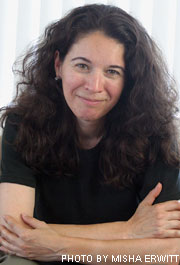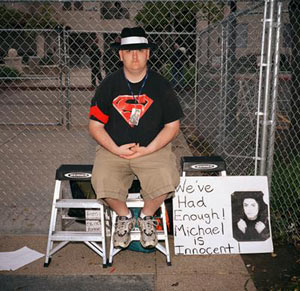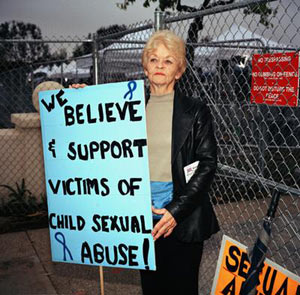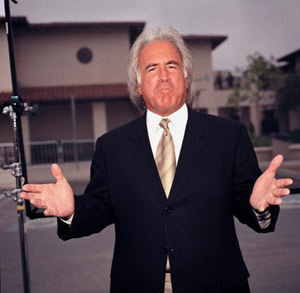 |
 | |||||||||||||
Camp Michael
|
 |
||||||||||||
|
As I arrive in the predawn darkness, a large crowd has already gathered outside the chain link fence surrounding the building where Michael Jackson is on trial. I am there early to secure a position in the press pen outside the entrance to the Santa Barbara County Superior Courthouse in Santa Maria. They are hoping to get a seat inside the courtroom to be near Michael. Many believe in their hearts that he is incapable of hurting a soul much less committing the crimes he is accused of and they defend him with a religious fervor. Michael, they say, is the victim.
No cameras are allowed in the courtroom and for still photographers in the unilateral position, the routine had quickly become predictable: standing on a step ladder with digital camera and a long lens, waiting to catch a few frames of Jackson as he walks in and out of the courthouse. There was plenty of downtime, so I decided to explore with a Mamiya 6 medium format film camera and a notebook. I wandered through the crowd, shot portraits and just talked to people. What compelled them so strongly to be there?
Hickman is one of dozens of die-hard fans standing outside the courthouse every day since the beginning of jury selection. They come from around the country and from as far away as England, France, Australia, Germany, Holland and Brazil. A mysterious group of young women from Japan, all dressed in white, hid their faces whenever a camera was pointed at them. In the background a boom box played Michael Jackson tunes as fans sang, hummed and danced along.
As the days and the weeks wear on and the crowd thinned out, a core group remained. On slow days when there are fewer than forty waiting outside the courthouse, everybody gets in. When there are more, lottery tickets are handed out. Santa Barbara County Sheriff Kenneth Clark pulls the tickets from an empty pretzel jar and calls each number one by one. Lucky individuals jump up and cheer, pump fists or hug friends when their number is called.
Satellite trucks line the parking lot inside a secure zone for those with special media credentials. White tents line the perimeter with cameras and TV reporters waiting to record the comings and goings of Jackson and broadcast the latest details of the trial. Journalists whose careers have spanned the likes of Rodney, OJ and Scott have now moved on to Camp Michael. Camera and sound technicians lounge on folding chairs during breaks between shooting stand-ups. Still photographers huddle over laptop computers when not perched on ladders.
I caught up with veteran AP reporter Linda Deutsch as she walked out of the courthouse on her way to file her story at the end of the day. She has covered every major trial in California for the last 36 years. Her first was Sirhan Sirhan. She covered the Manson trial, Patty Hearst, Rodney King, the Menendez Brothers, O.J. Simpson. She sums it up best:
"It touches a chord with the public. It affects them in a very visceral way. Because it's a celebrity people feel like they have a vested interest," she said, her eyes surveying the scene.
"A trial is another kind of theatre. It brings together so much human drama. So much is symbolic of what's going on in society, holding up our icons to a very bright spotlight. It distracts us from more serious things," she added before running off to meet her deadline.
"It's humbling, it's sad and difficult to watch and see", said Massi who has also worked as an on-air analyst for the O.J. Simpson and Scott Peterson trials. "This case is the ultimate example of a mega-superstar who's been famous for three decades; to see him go from celebrity to the walls of a courtroom. The case cuts both ways there are so many holes in this case." His voice trailed off.
© Monica Almeida
Dispatches are brought to you by Canon. Send Canon a message of thanks. |
|||||||||||||
Back to June 2005 Contents
|
|




